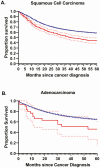Epidemiology of Cervical Adenocarcinoma and Squamous Cell Carcinoma Among Women Living With Human Immunodeficiency Virus Compared With the General Population in the United States
- PMID: 34143885
- PMCID: PMC8906686
- DOI: 10.1093/cid/ciab561
Epidemiology of Cervical Adenocarcinoma and Squamous Cell Carcinoma Among Women Living With Human Immunodeficiency Virus Compared With the General Population in the United States
Abstract
Background: Although cervical cancer risk overall is elevated among women living with human immunodeficiency virus (HIV; WLH), it is unclear whether risks are similarly elevated across histologic subtypes.
Methods: Data from the HIV/AIDS Cancer Match Study, a linkage of 12 US HIV and cancer registries during 1996 -2016, were used. Cervical cancers were categorized as adenocarcinoma (AC), squamous cell carcinoma (SCC), or other histologic subtype. Standardized incidence ratios compared rates of AC and SCC in WLH to those in general population. For WLH, risk factors for AC and SCC were evaluated using Poisson regression. Five-year survival was estimated by HIV status and histology.
Results: Overall, 62 615 cervical cancers were identified, including 609 in WLH. Compared with the general population, incidence of AC was 1.47 times higher (95% confidence interval [CI]: 1.03-2.05) and SCC was 3.62 times higher among WLH (95% CI: 3.31-3.94). Among WLH, there was no difference in AC rates by race/ethnicity or HIV transmission group, although SCC rates were lower among White women (vs Black) and higher among women who inject drugs (vs heterosexual transmission). Among WLH, 5-year overall survival was similar for AC (46.2%) and SCC (43.8%) but notably lower than for women not living with HIV.
Conclusions: Among WLH, AC rates were modestly elevated, whereas SCC rates were greatly elevated compared with the general population. These findings suggest there may be differences in the impact of immunosuppression and HIV in the development of AC versus SCC, given their common etiology in human papillomavirus infection.
Keywords: adenocarcinoma; cervical cancer; human immunodeficiency virus; squamous cell carcinoma.
© The Author(s) 2021. Published by Oxford University Press for the Infectious Diseases Society of America. All rights reserved. For permissions, e-mail: journals.permissions@oup.com.
Figures
Comment in
-
Letter to the Editor: Persisting Health Disparities in Women Living with HIV from the US.Clin Infect Dis. 2022 Mar 23;74(6):1124-1125. doi: 10.1093/cid/ciab675. Clin Infect Dis. 2022. PMID: 34427653 Free PMC article. No abstract available.
Similar articles
-
Cervical adenocarcinoma and squamous cell carcinoma incidence trends among white women and black women in the United States for 1976-2000.Cancer. 2004 Mar 1;100(5):1035-44. doi: 10.1002/cncr.20064. Cancer. 2004. PMID: 14983500
-
Second cancers after squamous cell carcinoma and adenocarcinoma of the cervix.J Clin Oncol. 2009 Feb 20;27(6):967-73. doi: 10.1200/JCO.2008.18.4549. Epub 2008 Dec 29. J Clin Oncol. 2009. PMID: 19114696 Free PMC article.
-
Trends in cervical cancer incidence rates by age, race/ethnicity, histological subtype, and stage at diagnosis in the United States.Prev Med. 2019 Jun;123:316-323. doi: 10.1016/j.ypmed.2019.04.010. Epub 2019 Apr 16. Prev Med. 2019. PMID: 31002830
-
Cervical neoplasia in women with HIV infection.Oncology (Williston Park). 1994 Aug;8(8):83-9; discussion 89, 93-4. Oncology (Williston Park). 1994. PMID: 7947005 Review.
-
Adenocarcinoma of the cervix: should we treat it differently?Curr Oncol Rep. 2015 Apr;17(4):17. doi: 10.1007/s11912-015-0440-6. Curr Oncol Rep. 2015. PMID: 25708801 Review.
Cited by
-
Endocervical adenocarcinomas and HPV genotyping in an HIV endemic milieu - a retrospective study.BMC Womens Health. 2025 Jan 15;25(1):20. doi: 10.1186/s12905-025-03555-z. BMC Womens Health. 2025. PMID: 39815240 Free PMC article.
-
Cervical cancer prevention and control in women living with human immunodeficiency virus.CA Cancer J Clin. 2021 Nov;71(6):505-526. doi: 10.3322/caac.21696. Epub 2021 Sep 9. CA Cancer J Clin. 2021. PMID: 34499351 Free PMC article. Review.
-
25-Hydroxycholecalciferol Serum Level Shows an Inverse Relationship with High-Grade Uterine Cervical Dysplasia in HIV-Uninfected Black Women in South Africa.J Clin Med. 2025 May 29;14(11):3817. doi: 10.3390/jcm14113817. J Clin Med. 2025. PMID: 40507578 Free PMC article.
-
Cancer treatment and survival among cervical cancer patients living with or without HIV in South Africa.Gynecol Oncol Rep. 2022 Sep 21;43:101069. doi: 10.1016/j.gore.2022.101069. eCollection 2022 Oct. Gynecol Oncol Rep. 2022. PMID: 36185101 Free PMC article.
-
A novel human papillomavirus and host DNA methylation score and detection of cervical adenocarcinoma.J Natl Cancer Inst. 2023 Dec 6;115(12):1535-1543. doi: 10.1093/jnci/djad134. J Natl Cancer Inst. 2023. PMID: 37467068 Free PMC article.
References
-
- Howlader N, Noone NA, Krapcho M, et al. (eds). SEER cancer statistics review, 1975–2012. Bethesda, MD: National Cancer Institute, 2015.
-
- Riethdorf S, Riethdorf L, Milde-Langosch K, Park TW, Löning T. Differences in HPV 16- and HPV 18 E6/E7 oncogene expression between in situ and invasive adenocarcinomas of the cervix uteri. Virchows Arch 2000; 437:491–500. - PubMed
-
- Rose PG, Java JJ, Whitney CW, Stehman FB, Lanciano R, Thomas GM. Locally advanced adenocarcinoma and adenosquamous carcinomas of the cervix compared to squamous cell carcinomas of the cervix in gynecologic oncology group trials of cisplatin-based chemoradiation. Gynecol Oncol 2014; 135:208–12. - PMC - PubMed
Publication types
MeSH terms
Grants and funding
- State of New York
- NU58DP006347-01/National Program of Cancer Registries
- P50 CA098252/CA/NCI NIH HHS/United States
- State of Maryland
- DP006302/CDC cooperative agreement
- U01 DP006302/DP/NCCDPHP CDC HHS/United States
- K08 CA228631/CA/NCI NIH HHS/United States
- NH/NIH HHS/United States
- Maryland Cigarette Restitution Fund
- Surveillance, Epidemiology, and End Results
- NU62PS003960/CDC National HIV Surveillance Systems
- HHSN261201800007C/CA/NCI NIH HHS/United States
- HHSN261201800002I/CA/NCI NIH HHS/United States
- Center for Disease Control
- State of New Jersey
- National Center for HIV, Viral Hepatitis, STD, and TB Prevention
- 0587200015/State of Louisiana
- U01DP006302/ACL/ACL HHS/United States
LinkOut - more resources
Full Text Sources
Medical
Research Materials


